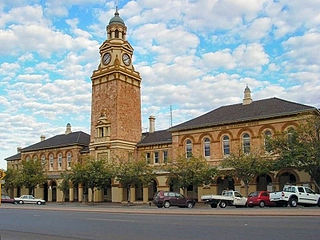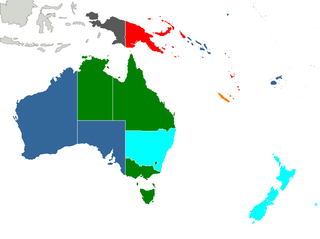Related Research Articles

Kalgoorlie is a city in the Goldfields–Esperance region of Western Australia, located 595 km (370 mi) east-northeast of Perth at the end of the Great Eastern Highway. It is sometimes referred to as Kalgoorlie–Boulder, as the surrounding urban area includes the historic townsite of Boulder and the local government area is the City of Kalgoorlie–Boulder.

Nevada is the only U.S. state where prostitution is legally permitted in some form. Prostitution is legal in 10 of Nevada's 17 counties, although only six allow it in every municipality. Six counties have at least one active brothel, which mainly operate in isolated, rural areas. The state's most populated counties, Clark and Washoe, are among those that do not permit prostitution. It is also illegal in Nevada's capital, Carson City, an independent city.

A red-light district or pleasure district is a part of an urban area where a concentration of prostitution and sex-oriented businesses, such as sex shops, strip clubs, and adult theaters, are found. In most cases, red-light districts are particularly associated with female street prostitution, though in some cities, these areas may coincide with spaces of male prostitution and gay venues. Areas in many big cities around the world have acquired an international reputation as red-light districts.

A brothel, bordello, bawdy house, ranch, house of ill repute, house of ill fame, or whorehouse is a place where people engage in sexual activity with prostitutes. However, for legal or cultural reasons, establishments often describe themselves as massage parlors, bars, strip clubs, body rub parlours, studios, or by some other description. Sex work in a brothel is considered safer than street prostitution.
Betty Jean O'Hara was a famed prostitute in Honolulu's "vice district" during World War II.
Phoebe Doty was an American prostitute and madam. In 1821, she started her career in a bordello in the Five Points neighborhood of New York City. Over the next three years, she accrued $600 in personal belongings. For the next decade or so, Doty moved from house to house, eventually settling in a brothel on Church Street. There she was valued at $800. Doty had an adopted daughter, Sal Wright, who also became a prostitute.

Julia Brown was an American madam and prostitute active in mid-nineteenth century New York City. Brown has been described as "the best-known prostitute in antebellum America". Brown was known for playing the piano in her brothel and for being a guest at functions hosted by the best families in New York. She also had season ticket to two theaters, paid for pews in various churches and contributed generously to local bible societies. She became a popular subject of tourist guidebooks, and her name appears often in diaries from the period.
Prostitution in South Korea is illegal, but according to The Korea Women's Development Institute, the sex trade in Korea was estimated to amount to 14 trillion South Korean won in 2007, roughly 1.6% of the nation's GDP. According to a survey conducted by the Department of Urology at the Korea University College of Medicine in 2015, 23.1% of males and 2.6% of females, aged 18–69, had sexual experience with a prostitute.

Prostitution is illegal in the vast majority of the United States as a result of state laws rather than federal laws. It is, however, legal in some rural counties within the state of Nevada. Additionally, it is decriminalized to sell sex in the state of Maine, but illegal to buy sex. Prostitution nevertheless occurs elsewhere in the country.
Prostitution in Ireland is legal. However, since March 2017, it has been an offence to buy sex. All forms of third party involvement are illegal but are commonly practiced. Since the law that criminalises clients came into being, with the purpose of reducing the demand for prostitution, the number of prosecutions for the purchase of sex increased from 10 in 2018 to 92 in 2020. In a report from UCD's Sexual Exploitation Research Programme the development is called ”a promising start in interrupting the demand for prostitution.” Most prostitution in Ireland occurs indoors. Street prostitution has declined considerably in the 21st century, with the vast majority of prostitution now advertised on the internet.

Procuring, pimping, or pandering is the facilitation or provision of a prostitute or other sex worker in the arrangement of a sex act with a customer. A procurer, colloquially called a pimp or a madam or a brothel keeper, is an agent for prostitutes who collects part of their earnings. The procurer may receive this money in return for advertising services, physical protection, or for providing and possibly monopolizing a location where the prostitute may solicit clients. Like prostitution, the legality of certain actions of a madam or a pimp vary from one region to the next.

Prostitution in Australia is governed by state and territory laws, which vary considerably, although none ban the selling of sex itself.

Mattie Silks, or Martha Ready, was a prostitute and leading madam in the late 19th century American West.
Prostitution is the business or practice of engaging in sexual activity in exchange for payment. The definition of "sexual activity" varies, and is often defined as an activity requiring physical contact with the customer. The requirement of physical contact also creates the risk of transferring infections. Prostitution is sometimes described as sexual services, commercial sex or, colloquially, hooking. It is sometimes referred to euphemistically as "the world's oldest profession" in the English-speaking world. A person who works in the field is usually called a prostitute or sex worker, but other words, such as hooker, putana, or whore, are sometimes used pejoratively to refer to those who work as prostitutes.
Prostitution in Malaysia is restricted in all states despite it being widespread in the country. Related activities such as soliciting and brothels are illegal. In the two states of Terengganu and Kelantan, Muslims convicted of prostitution may be punishable with public caning.

Mary-Anne Kenworthy is a Western Australian brothel owner and businesswoman. Kenworthy is an advocate for the legalisation of prostitution and improving the rights of sex workers.

The Dumas Brothel was a brothel in Butte, Montana. The brothel was founded by French-Canadian brothers Joseph and Arthur Nadeau in 1890 and named after the nominal owner, Delia Nadeau, née Dumas, who was Joseph's wife. It grew considerably through the years, with the miners employed by the city's copper mines often patronizing the establishment. After several changes of the "madams" and continuing pressure from authorities, the brothel closed in 1982, described as "a rare, intact commentary on social history". At the time of its closure, it was the longest operating brothel in the United States, having operated years after prostitution was made illegal. After closing, the brothel changed hands several times, eventually becoming a tourist attraction owned and managed by a series of Butte residents.

Langtrees is Australia's largest bordello brand, with premises in Perth and Canberra. It is owned by Mary-Anne Kenworthy, Australia's most well-known madam.

Prostitution in Oceania varies greatly across the region. In American Samoa, for instance, prostitution is illegal, whereas in New Zealand most aspects of the trade are decriminalised.
References
- ↑ "Prostitution". Western Australian Museum. Government of Western Australia. 2017. Retrieved 6 March 2024.
Prostitutes appeared on the streets of Kalgoorlie from its earliest days. [...] In 1902 west Brookman Street was re-gazetted as Hay Street and became the famous 'red light district' of Kalgoorlie. Prostitutes had to register with the police, live in the brothels where they were employed and could not socialise with the local community. The regulations were enforced by local police in cooperation with brothel madams, despite a lack of formal authority. It was not until 1995 that prostitutes were allowed to live in private accommodation and be part of the community.
- ↑ Haselhurst, David (10 July 1984), "Sounding the drums of Kalgoorlie: prostitution", Bulletin (Sydney) (10 July 1984): 48–50, ISSN 1440-7485
- ↑ Egan, Colleen (23 February 1995), "Proper madams", Australian (23 Feb 1995): 11, ISSN 1038-8761
- ↑ Australian Broadcasting Corporation. Radio National (19 August 2005), Beautiful ladies, pretty lights - a history of Kalgoorlie's brothels, Australian Broadcasting Corporation, retrieved 5 March 2017
- ↑ Smith, Robin (Robin Vaughan Francis) (1988), Prostitutes being displayed in brothel hallways on Hay Street, Kalgoorlie, Western Australia, 1988 , retrieved 5 March 2017
- ↑ Garwood, Roger (1990), Brothel at 141 Hay Street, Kalgoorlie (BA2531/850) , retrieved 5 March 2017
- ↑ Ainslie, Trish; Garwood, Roger, 1945- (1992), Stella, Hay Street, Kalgoorlie , retrieved 5 March 2017
{{citation}}: CS1 maint: multiple names: authors list (link) CS1 maint: numeric names: authors list (link) - ↑ Ainslie, Trish; Garwood, Roger, 1945- (1990), Hay Street, Kalgoorlie, 1990 , retrieved 5 March 2017
{{citation}}: CS1 maint: multiple names: authors list (link) CS1 maint: numeric names: authors list (link) - ↑ "Fined for brothels". The Canberra Times . Vol. 41, no. 11, 691. Australian Capital Territory, Australia. 18 May 1967. p. 10. Retrieved 5 March 2017– via National Library of Australia.
- ↑ "Controversy rages over Kalgoorlie's street of sin". The Canberra Times . Vol. 52, no. 15, 590. Australian Capital Territory, Australia. 29 May 1978. p. 2. Retrieved 5 March 2017– via National Library of Australia.
- ↑ Jarrod Lucas (9 July 2019). "Kalgoorlie's 'Pink House' the last brothel standing on Hay Street's historic red-light district". Australian Broadcasting Corporation. Retrieved 11 January 2020.